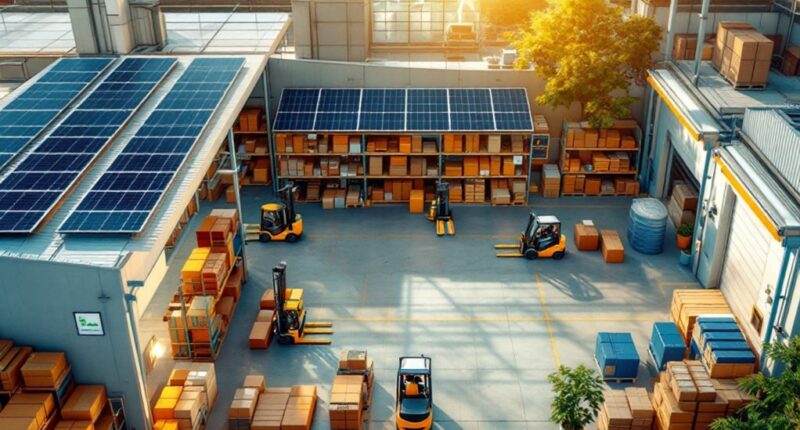Supply chain sustainability assessments track products from cradle to grave, revealing hidden environmental and social impacts. Companies use a toolkit of self-assessments, on-site audits, third-party verification, and life cycle analyses to measure their footprint beyond factory gates. Modern technologies like blockchain and AI accelerate this process, creating transparent supply networks. These assessments deliver tangible benefits: disruption resilience, cost savings, enhanced reputation, and regulatory compliance. The journey toward sustainable supply chains continues with each new innovative assessment methodology.

Nearly every product we touch has traveled through a complex web of suppliers, manufacturers, and distributors before reaching our hands—yet the environmental and social footprints left along this journey often remain invisible to consumers. Supply chain sustainability assessment has emerged as the corporate world’s answer to this invisibility problem, functioning as a sort of environmental detective work that follows products from cradle to grave.
Organizations are increasingly recognizing that their sustainability responsibility doesn’t end at their factory gates. Like a game of environmental hot potato, companies must now account for what happens upstream with suppliers and downstream with product disposal. This holistic approach examines everything from carbon emissions (nature’s unwelcome party favor) to labor practices (because nobody wants their sneakers made in sweatshops). A comprehensive sustainability strategy must assess the entire supply chain to identify improvement areas and establish measurable sustainability goals.
The assessment toolkit resembles a Swiss Army knife of evaluation methods. Self-assessment questionnaires act as the initial screening—think of them as first dates with suppliers, getting to know their sustainability values. On-site audits function as the surprise home visits, where the real habits are revealed. Third-party verification adds that essential stamp of “we’re not just taking their word for it,” while life cycle assessments track a product’s environmental journey with the diligence of an overprotective parent. Research shows that eight global supply chains are responsible for over 50% of emissions worldwide, highlighting the critical importance of these assessments.
Supply chain assessments: where questionnaires are first dates and audits are surprise home visits into your supplier’s sustainability habits.
Technology has revolutionized these assessments faster than teenagers adopt new slang. Blockchain solutions create tamper-proof records of supply chain activities. AI systems predict sustainability risks with eerie accuracy, like a fortune-teller who actually got it right. Carbon calculators quantify emissions with precision that would make your high school math teacher weep with joy.
The benefits extend beyond feeling warm and fuzzy about corporate responsibility. Effective assessments build resilience against supply disruptions, cut costs through efficiency improvements, and polish brand reputation to a mirror shine. In today’s market, sustainability isn’t just nice-to-have—it’s increasingly the price of admission to consumer hearts, investor portfolios, and regulatory compliance. After all, in the corporate world, green is the new black.
Frequently Asked Questions
How Can Sustainability Metrics Be Aligned With Business Growth Objectives?
Organizations can align sustainability metrics with business growth by integrating environmental and social KPIs into performance scorecards alongside financial targets. Companies should identify metrics that create dual value—like resource efficiency that reduces both costs and environmental impact.
What Are the Financial Costs of Implementing Sustainability Assessments?
Implementing sustainability assessments carries significant financial implications across multiple categories. Organizations face upfront costs for data tools, staff training, and specialized expertise.
Operational expenses include ongoing data management, software subscriptions, and verification processes. Compliance requirements add reporting costs and potential certification fees.
However, these investments often yield long-term financial benefits through operational efficiencies, lower capital costs, improved access to sustainable financing, and enhanced market position—transforming what appears as an expense into a strategic investment.
Which Sustainability Certifications Provide Competitive Market Advantages?
Several sustainability certifications offer significant market advantages. B Corp certification attracts ESG-conscious investors and enhances brand reputation. LEED certification increases property value and appeals to environmentally aware tenants. ISO 14001 facilitates access to new markets while improving regulatory compliance. Fair Trade certification differentiates products and builds consumer trust.
These certifications not only demonstrate commitment to sustainability but also provide tangible competitive edges through improved stakeholder relations, cost efficiencies, and market differentiation.
How Do Cultural Differences Impact Global Sustainability Assessment Initiatives?
Cultural differences profoundly influence global sustainability assessment initiatives through varying priorities and communication styles. High-context versus low-context cultures interpret sustainability metrics differently, while collectivist societies often emphasize community impact over individual metrics. Western-centric frameworks frequently fall short in diverse settings, creating implementation gaps.
Religious beliefs and time perception also shape environmental attitudes. For effective global assessments, organizations must develop culturally adaptive indicators and engage with indigenous knowledge, traversing the complex interplay between local customs and international standards.
Can Blockchain Technology Enhance Supply Chain Sustainability Transparency?
Blockchain technology profoundly enhances supply chain sustainability transparency through its immutable ledger system. Companies can now track products from origin to consumer, verifying ethical sourcing claims with tamper-proof records.
This digital backbone provides unprecedented visibility into environmental impacts, labor practices, and compliance adherence. Despite implementation challenges like scalability and stakeholder adoption, the technology’s 90.2% projected market growth indicates its transformative potential. For sustainability professionals, blockchain represents a powerful truth-telling tool in an era where consumers increasingly demand ethical production verification.









